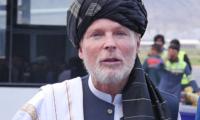ISLAMABAD: On 5 February 2002, around midday, Deputy Inspector General (Police) Javed Noor was at his official residence in Lahore when he received a call from the then provincial Home Secretary Brigadier (r) Ejaz Shah. He informed Noor about some ‘significant progress’ made regarding the Daniel Pearl’s kidnapping case.
Brigadier Shah said Ahmad Omar Saeed Sheikh, the main suspect in the case at that time, had surrendered. Until then no one was aware that Pearl had, in fact, been killed. Shah wanted the accused handed over to the police through due legal process. Police, on the contrary, had already rounded up his elderly grandfather Sheikh Muhammad Ismail and paternal uncle Tariq Ismail along with a few women of the family from Mohni Road and Johar Town areas in Lahore – ostensibly as part of practice to help investigation process.
Omar Sheikh's maternal uncle, Sheikh Abdur Rauf, was posted as a District and Sessions Judge in Muzaffargarh at the time. Having assessed the case in detail, he was instrumental in convincing his nephew to give himself up. Interestingly, Judge Rauf was a good friend of DIG Noor, so the matter of handing Omar over proceeded smoothly.
“We were fearful of a fake police encounter. The DIG was a former class fellow so we went to see him,” Sheikh Rauf told this correspondent recently. He also shared details of events that followed.
Police were not the only force involved in proceedings against Sheikh’s family. Other security institutions were also active. When DIG Noor informed Brigadier Shah that he Omar was at his home, he promptly reached there but then left immediately. Omar, the suspect until then and later the main accused, arrived at Noor’s residence with his father, Saeed Ahmad Sheikh and his maternal uncle Sheikh Abdur Rauf.
Rauf briefed Noor about the case, which then had a chat with Omar about his ideology and beliefs. During their conversation, the calls for Zohar prayers were heard. Noor asked Omar if he wanted to pray he could do so in his house. In fact, he asked him to lead the prayers. “He was impressive and I thought he was a better Muslim amongst all of us present there so I invited him to lead the prayers,” Noor told this correspondent many years ago.
The meeting was followed by formal procedures for the arrest. The police and intelligence agencies interrogated Omar before sending him off to Karachi on 12 February 2002 on a PIA flight under the maximum security.
DIG Noor personally narrated the story of Sheikh's arrest to me years ago. Omar’s father and uncle of had confirmed his account. Brig Shah also verified the entire account in 2014 when I met him at his home in Lahore.
When the court hearing began for Daniel Pearl’s murder case, the police astonishingly took the position in the charge sheet that Omar had actually been arrested from Karachi Airport on 12 February 2002. Omar, on the contrary, had said in his own confession that he had courted arrest on 5 February 2002, and that he had been brought on a PIA flight to Karachi on 12 February the same year. His father and uncle were his defence witnesses in the court. Media reports of his arrest from Lahore played a vital role in weakening the position of the state against Omar.
Omar’s lawyer, Mahmud A Sheikh also presented news clippings and TV footages of his arrest. The prosecution had no response to this. The natural question is why did the police lie about Omar’s arrest in such an important case? No one has answered this yet.
The story of Daniel Pearl’s case started when the journalist landed in Karachi a day after 9/11. After spending some time in Karachi since arriving from India, the Wall Street Journal journalist started searching for one Mubarak Ali Gilani for his alleged connections with a militant called Richard Reid. Arrested in Europe, Reid was reportedly a British terrorist who tried to blow up a Paris to Miami flight with a bomb hidden in his. The search for Gilani introduced Pearl to Ahmad Omer Saeed Sheikh.
Police and prosecution’s record say Omar first appeared in relation to the Daniel Pearl case on 11 January 2002 at Akbar International Hotel in Rawalpindi. He met Pearl through Asif Farooqi, a journalist working with Pearl at the time. It was also Farooqi’s first meeting with Omar and he did not know that the man meeting them as “Bashir” was actually Omar Sheikh. Interestingly, Omar was staying at the same hotel as Faruq Muzaffar - his other alias.
“The meeting lasted for almost over an hour. Omar spoke English in a made up accent so I could not judge if he had British grooming. Omar pretended to be a disciple of Gilani, and said he would try to arrange a meeting between Gilani and Pearl,” recalls senior journalist Raza (not a real name), who spoke for the first time to this correspondent after 18 long years of this incident. He is a witness to the meeting.
Prosecution claimed in the court that the conspiracy to murder Pearl was hatched in the same hotel room on 11 January 2002 where two more accused Fahad Nasim and Syed Suleman Saqib were also present.
Nasim and Saqib are two Karachi-based cousins who according to the police sent e-mails to Pearl’s wife and US authorities listing demands in return for Pearl’s release. Prosecution, however, remained unable to corroborate the presence of the two men through any proof or a witness.
A few days after the 11 January 2002 meeting, Omar called Pearl and asked him to come to Karachi. On 23 January 2002, before proceeding to meet Omar (Bashir), Pearl called Asif Farooqi asking if it was okay to meet him. Farooqi gave him two tips – “meet the man in a public place and don’t take your wife along”. Pearl told Farooqi his wife won’t be accompanying him and he would be meeting Bashir (Omar) and Gilani at a public place.
On that fateful day, Pearl met with a man named Jameel Yusuf Ahmed, a businessman and founder of Citizen Police Liaison Committee (CPLC) in Karachi. Ahmed later confirmed that during their meeting Pearl received a call and said to the caller that, “I am near your office. I remember I have to meet you.”
Soon after, Pearl left Ahmed’s office to meet Bashir (Omar). Pearl drove to the Metropole Hotel from Ahmed's office by a taxi driver named Nasir Abbas and this was the last time when the American journalist was seen alive publically. According to the taxi driver, as soon as his taxi came to a halt, a white corolla pulled up and he saw a man (later identified as Omar) coming out of the car and then meeting the Pearl and they departed together.
Data related to the call made to Pearl and the number it was made from were presented to the court by the prosecution. It turned out that the phone number mentioned was not Omar’s but of someone called Mr Siddiqui in Karachi. Hence, this lead also went nowhere in the
court. The question arises why the prosecution did not check the identity of the phone number they had presented in the court? Defence also took the position that the man presented in the court as the taxi driver was, in fact, a police officer. This also raises certain questions. For example, why did the police rely on a false witness? Did the police acted independently or under order orders?
The saga of weak investigations and prosecution in Pearl’s case did not end here. It continued until the end of the case in the Supreme Court.
(To be concluded)
Both reiterate commitment to further enhancing partnership, emphasising importance of continued cooperation
Pair say their father had been raping eldest girl for a year, and had twice attempted to rape younger girl
First meeting of committee, chaired by Minister for Law and Justice Azam Nazeer Tarar, was held on Wednesday
A re-polling was held at 15 polling stations of this constituency on January 5







